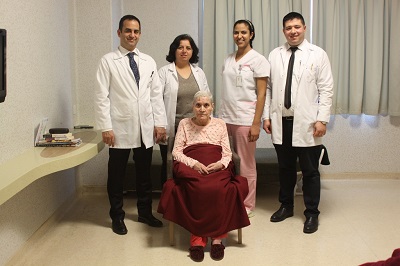
Near East University Hospital's neurosurgeons are on the leading edge of treating neurological conditions using the innovations and state-of-the-art techniques in neurosurgery. The Head of the Neurosurgery Department of Near East University, Assoc. Prof. Dr. Doğa Gürkanlar delivered information about the 76-year-old patient Aynur Kovanbey and the procedure carried to restore her health "The patient admitted to Near East University Hospital and diagnosed with brain hemorrhage caused by ruptured aneurysm. She was also experiencing some health problems such as accumulation of fluid in the brain, vasospasm and hypertension. The general health condition of the patient was risky for an immediate surgery. So, the patient was kept under medical care in ICU (intensive care unit) in a state of unconsciousness for 4 months. As a result of a patient-tailored intensive treatment plan, the risk factors were eliminated. Then, an open surgery was performed and the patient's health was restored by a microsurgical procedure followed by rehabilitative therapy.
Brain hemorrhage is life threatening.
Underlining that hemorrhagic stroke means bleeding in brain that occurs when aneurysm ruptures, Assoc. Prof. Dr. Doğa Gürkanlar states that hemorrhagic stroke is life threatening. “Up to 10-15 percent of patients with brain hemorrhage die before reaching a health center, and up to 50 percent of people admitted to hospitals due to brain hemorrhage lose their lives despite intervention. For those who survive a brain hemorrhage, recovery is slow. Only 12% of people are able to recover complete or near-complete functioning. Near East University Hospital’s neurologists and neurosurgeons are highly qualified and have experience treating all types of brain and nervous system conditions. They work as a team to tailor the most appropriate treatment option for patient's condition. The neurologists and neurosurgeons of Near East University Hospital have successfully treated and discharged many patients with brain hemorrhage so far. The survival rate of these patients is much higher than the world stats” noted he.
Assoc. Prof. Dr. Doğa Gürkanlar: "Severe headache — the worst headache you've ever had that is different from other headaches, may be a symptom of brain hemorrhage"
Underlining that an aneurysm is a localized, blood-filled balloon-like bulge in the wall of a blood vessel which causes bleeding into brain when bursts or ruptures, Associate Professor Gürkanlar states that various factors may cause to develop aneurysm.
"Brain aneurysms develop as a result of thinning artery walls. A number of factors can contribute to weakness in an artery wall and increase the risk of a brain aneurysm or aneurysm rupture. An aneurysm may be a result of a hereditary condition, acquired disease, or other risk factors. Cigarette smoking, high blood pressure (hypertension), heavy alcohol consumption, diabetes, arteriosclerosis, trauma, some infections and genetic predisposition are the factors that trigger brain hemorrhage.
A sudden and severe headache that has never been experienced before, nausea and vomiting, neck pain or stiffness, blurred or double vision, light sensitivity, fainting or loss of consciousness, and seizures are symptoms that should be seriously taken into consideration by patient and patient's relatives. Patients with such symptoms should seek immediate medical attention” said he.
Assoc. Prof. Dr. Gürkanlar: "As the patient's general health was bad, she was treated in the intensive care unit, where she was placed in a state of unconsciousness for about four months, and her general health was improved"
Assoc. Prof. Dr. Doğa Gürkanlar delivered information about the 76-year-old patient Aynur Kovanbey and the procedure carried to restore her health: “76 year-old patient Aynur Kovanbeyi, who was referred to Near East University Hospital about five months ago by the health facility to which the patient admitted with complaints of vomiting and loss of consciousness, was diagnosed with middle cerebral artery aneurysm by the Neurosurgery Department of Near East University Hospital. As the patient's general health was bad, she was treated in the intensive care unit, where she was placed in a state of unconsciousness for about four months, and her general health was improved”.
Explaining that the patient was suffering from severe headache, high blood pressure (hypertension), pressure on the brain from excess cerebrospinal fluid accumulation (hydrocephalus), and vasospasm related to a ruptured middle cerebral artery aneurysm, Associate Professor Doğa Gürkanlar underlined that patient’s general health condition was very risky for an immediate open surgery. “An appropriate medication was tailored to eliminate all risk factors. After about four month lasting well-planed care and treatment, all complications were taken under control and the patient was brought into a state to undergo an open surgery procedure. Then, through a microsurgical approach, the neurosurgeons from the department of neurosurgery performed a successful clipping of aneurysm procedure”.
Through the rehabilitative therapy program carried out by the Department of Physiotherapy and Rehabilitation, the patient regained her consciousness, functional status, mobility, and personal skills required for planning and programing activities of daily living.
Stating that damage to the brain due to hemorrhage resulted in the need for rehabilitative therapy, Associate Professor Doğa Gürkanlar underlined that the well-tailored physiotherapy and rehabilitation program helped the patient to regain many of her skills that she lost due to brain hemorrhage. "The patient's recovery process is going on now. She has already regained her cognitive functions and mobility; she can easily move her joints and she can walk".